 |
Junkers Ju 88 A5 Werke No. 8138 - Banks Marsh
7/8th April 1941 |
Last
updated: 27.07.2018

|
Ju 88 A4 (Visually similar to the A5) - Note externally mounted bomb load
|
| Type |
Werke No. |
Unit |
Base |
Duty |
Crew |
| Ju 88 A5 |
8138 |
II Gruppe, Kampfgeschwader 54 |
Saint-André-de-l'Eure, Normandy, France |
Night Bombing Raid |
4 |
During
WW2 our region was largely associated with training of aircrews and
aircraft building and maintenance, seeing relatively little of the
intense aerial combat witnessed by the southern counties, despite the
cities of Manchester and Liverpool suffering heavy and sustained
bombing campaigns by the Luftwaffe. The relative paucity of aerial
combat over the region has meant that the few incidents that did take
place have received considerable attention from other groups in the
past, but one has always eluded all those who have attempted to find
the crash site of the Ju 88 shot down over the Ribble estuary marshes.
Our research into this incident began in the early 1980s, with
information drawn from numerous official records, local archives and
interviews with individuals who were either directly involved or
witnessed the event and its immediate aftermath. However our early
visits to the marsh only highlighted the sheer size of the potential
area to be searched as well as the inadequacies of metal detecting
equipment available at the time and it was not until the late 1990s
that we began to search seriously for the crash site.
Following
a brief respite over the winter of 1940, Spring 1941 had seen a renewed
Luftwaffe bombing campaign against Britain, which from March to June
was directed against the country's major ports, with heavy attacks on
Liverpool, Belfast, Clydebank, Hull and Plymouth. The night of 7/8th
April 1941 was a busy one for the Luftwaffe with some 517 aircraft
involved in offensive operations against Britain, with Luftflotte 2 and
3 mainly targeting the Clydeside / Glasgow port areas, with Greenock,
Dumbarton and Hillington all being designated targets. However, as on
previous raids on Clydeside targets, the bombing of the intended
military targets proved far from effective due to effective
anti-aircraft protection around the intended military targets, which
saw most of the bombs falling on residential areas. On the night of the
7/8th April, the raiders had the added obstacle of poor
visibility over Clydeside with only 179 of the raiders actually
releasing their bombs in the intended target area and many raiders
having to turn way and head for their assigned alternative targets. One
of the raiders on that April night was Ju 88 A-5 Werke Nr. 8138, Code
B3+IN of II Gruppe, Kampfgeschwader 54, based at Saint-André-de-l'Eure
in the Normandy region of northern France. This aircraft was one of
seven Ju 88s from II/KG 54 taking part in the raid and it took off on
the evening of Monday the 7th April loaded with two SC500 bombs mounted
on its external bomb racks, destined for Greenock - the primary target
for some 200 raiders that night. The crew for the flight comprised; 30
year old Oblt. Gunter Klemm (pilot), 25 year old Lt. Heinrich Coster
(navigator), 26 year old Fw. Alfred Helmut Michael Hofmann (radio
operator) and 25 year old Fw. Hermann Ilse (flight mechanic). However
despite reaching the target area successfully, the crew found their
primary target obscured by dense cloud. Although some 97 aircraft did
attack Greenock, dropping 102 tonnes of High Explosive bombs (Blitz
Then & Now Vol: 2), Klemm's crew and some 100 other raiders were
ordered to fly on to their secondary targets, most heading for
Liverpool and Bristol.
At around 23:30 hours Klemm's Ju 88 was
one of around 40 raiders, all individually approaching their designated
secondary objective of Liverpool and presumably the crew had begun
looking out for their target - the docks area. They were flying in a
moonlit, clear sky at approx 10,000 feet, with a cloud layer below at
approx 5000 - 6000 feet and found themselves heading towards an
anti-aircraft barrage on the outskirts of the city. Unknown to the
crew, but probably not unexpected, a number of RAF night fighters -
Defiants from No. 256 Squadron, based at RAF Squires Gate near
Blackpool - were also on patrol over the city, providing
defensive cover in anticipation of an expected attack. In fact, not far
from the Ju 88 another drama was playing out over Southport when at
around the same time, one of the RAF night fighters was getting into
serious difficulties. Defiant N1694 had taken off earlier that
night, piloted by Flight Sgt. J. Stenton, with his gunner Sgt W. Ross.
However, during the patrol their aircraft suffered a major electrical
equipment failure, resulting in the crew electing to abandon the
aircraft, leaving their aircraft to crash on farmland close to Lowlands
Farm, Halsall near Southport at 23.45.
At 23:43 hours another
No. 256 Squadron crew, who were waiting at readiness at Squires Gate,
were ordered to take off and patrol at 10,000 feet over the north
west coastal area. They were; Flt. Lt. Donald Rock West (pilot) and
Sgt. Reginald Thomas Adams (air gunner), both aged 20 and their
aircraft was a Boulton Paul Defiant Mk.1 N3445, coded "JT - F". They
were both relatively experienced on Defiants - West having flown his
first sortie in August 1940 with No. 141 Squadron and Adams, with 264
Squadron in September. Both had joined No. 256 Squadron in
December that year, being paired up as a crew together and with West
becoming 'A' Flight Commander. At 23:45 the Defiant climbed above
the cloud layer, which was by then 10/10ths at 3000 feet and climbed to
10,000ft, where they began to circle slowly, but saw nothing. With no
orders, or information on activity in their vicinity, received by radio
from operations, Flt. Lt. West decided to head towards the
Anti-Aircraft Barrage which he could see was active over Liverpool. As
the shellbursts appeared to be at around 10,000ft, he increased height
to 11,000ft and then followed a course of 180° for several minutes.
Suddenly Sgt. Adams reported an aircraft at ‘9 o’clock below’
silhouetted in the moonlight against the lower cloud layer. West
immediately looked in the direction indicted and saw what he described
as an "ugly looking silhouette" approximately 100 feet below them and
to their port side.
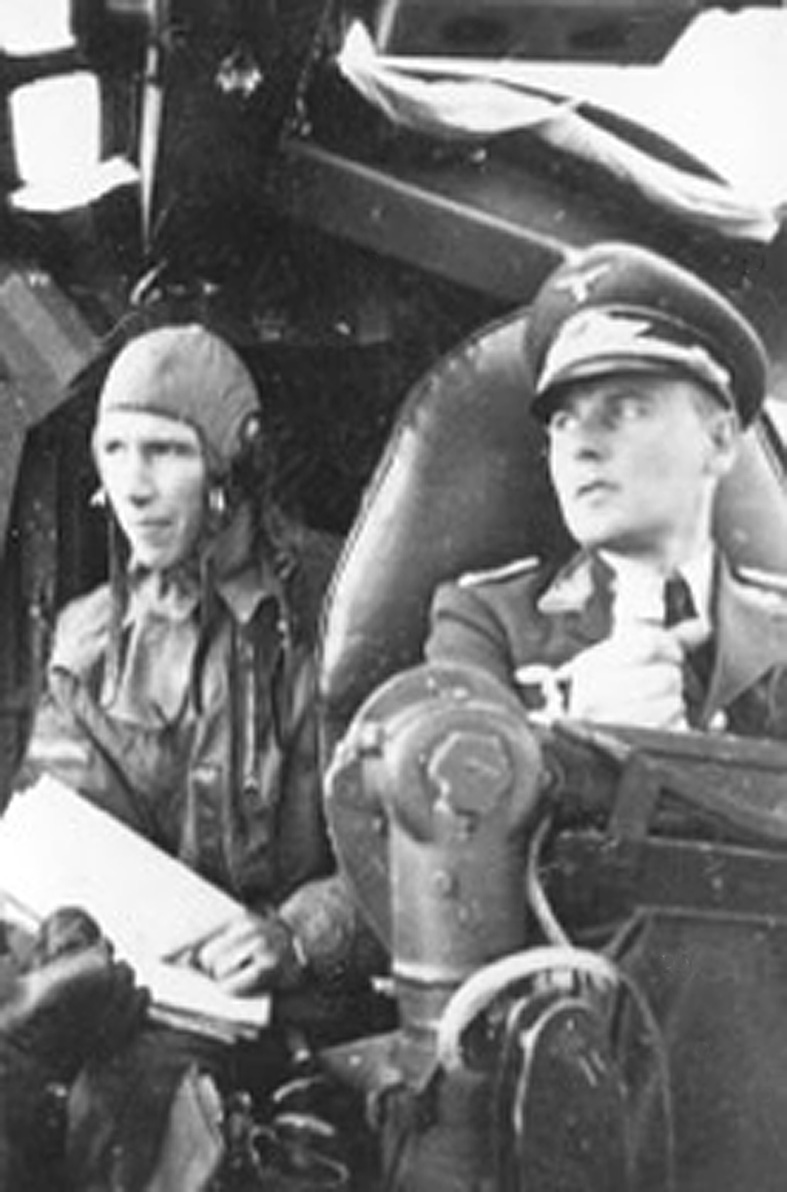 |
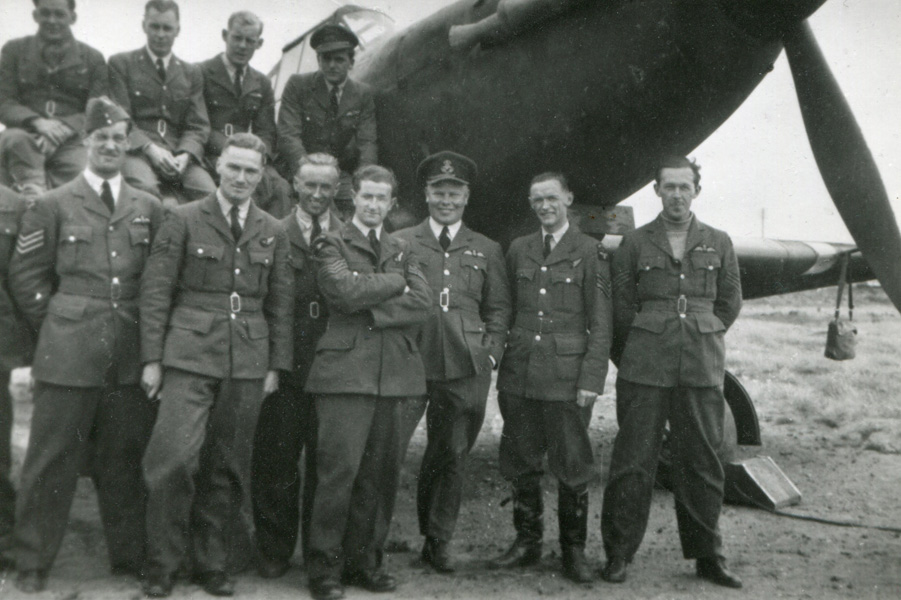 |
| Oblt. Gunter Klemm (right) at the controls of a He III in 1940. (Photo: Klemm family via Russell Brown) |
No. 256 Squadron crews pose next to one of their Defiants -
Flt. Lt. D.R. West sits on the wing - top row, furthest to the right
and Sgt. R.T. Adams directly below him - bottom row third from the
left. (Photo: Russell Brown Collection) |
| Name |
Age |
Position |
Fate |
| Oblt. Gunter Klemm |
30 |
Pilot |
I. |
Lt. Heinrich Coster
|
25 |
Navigator |
I. |
| Fw. Alfred Helmut Michael Hofmann | 26 | Radio Operator | K. |
| Fw. Hermann Ilse | 25 | Flight Mechanic | K. |
With
the other aircraft positively identified as a Ju88 by Sgt. Adams, Flt.
Lt. West now decided to carry out Fighter Command attack ‘A’ and began
by diving below and away from the target aircraft. This put his
Defiant some 3000 yards in front and 1000 feet below the enemy raider
and from this position West manoeuvred his aircraft by gently pulling
the nose up and using right rudder until he was about 150 yards below
and 200 yards to the starboard side of the raider. As the Ju 88
overtook the Defiant slightly, apparently unaware of the night
fighter's presence, Flt. Lt. West ordered his gunner to open fire and
Sgt. Adams fired a two second burst, accurately targeting the starboard
engine, which immediately burst into flames. The crew of the Ju88,
clearly now alerted to the presence of the Defiant, returned fire from
the upper rear gun position, firing several short bursts, all of
which passed well above the Defiant, leading Flt. Lt. West to conclude
that the enemy gunner could not depress his gun enough to fire
accurately. He then closed to 100 yards from the enemy aircraft
and Sgt Adams fired a one and half second burst, again targeting
the starboard engine, which became even more engulfed in flames and the
Ju 88 began to lose speed and height. At this point Flt. Lt. West
manoeuvred the Defiant ahead of and slightly below the Ju 88 to give
his gunner a better chance of firing into the cockpit and proceeded
cross from side to side across the Ju 88's nose. Again the night
fighter came under return fire, this time from the upper front gun
position, but again the enemy's tracer bullets showed that the line of
fire was too high and passed harmlessly above them. Sgt. Adams
responded with two one and a half second bursts of fire towards the gun
positions and into the cockpit, noting the explosive "de Wilde" bullets
(almost certainly actually British B Mark VI incendiary bullets -
often termed "de Wilde" at the time) bursting inside the glazed nose of
the enemy aircraft and the return fire immediately ceased.
By
this point the Ju-88's fate was undoubtedly sealed and Flt. Lt. West
was forced to break away to port as the crippled enemy aircraft began a
shallow dive above him. He then executed a steep 360 degree turn
in order the position his Defiant to the enemy aircraft's port side for
another attack, but no such coup de grace was needed, as suddenly the
Ju 88 went into a steep dive and entered the cloud layer below. On
board the stricken bomber the situation must have been chaos - the
aircraft was by now well alight and described by some witnesses on the
ground as resembling "a flaming streak" as it dived out of the base of
the cloud layer. As the Ju88 descended, one of the 500kg bombs was
jettisoned and the crew prepared to bail out. First to leave was Lt
Coster, followed by Oblt. Klemm, the pilot, who was badly wounded and
then the radio operator, Fw. Hofmann, who for reasons unknown took one
of the aircraft's radio sets with him when he jumped! The flight
engineer Fw. Ilse did not mange to leave the aircraft, probably due to
having either been too badly wounded or killed during the battle.
The
falling bomber was by this point heading in a northerly direction
towards the town of Lytham, but it gradually turned as it passed over
the Ribble estuary and impacted on the edge of the marshes bordering
the south side of the river channel near the village of Banks.
The Defiant followed its victim down through the cloud layer, emerging
just in time for West and Adams to observe a vivid red flash on impact
and then witness the blazing wreckage of the Ju88, as they continued
back to RAF Squires Gate, landing at 00.12hrs on the 8th April, where
it was later noted that they had fired 621 rounds during the
engagement. Unfortunately any celebrations of what was No. 256
Squadrons first victory, must have been tempered by the loss at 04:50
that morning of two crew members; Sgt. John Denis Harold Cunningham
(pilot) and Sgt. Albert Douglas Wood (air gunner, RNZAF) who were both
killed when Defiant N3424 lost height and crashed on takeoff from
Squires Gate.
At around
midnight, numerous locals who had been alerted by the sound of the
combat overhead, now witnessed the Ju88 explode as it struck the marsh,
with such force that many assumed the remaining bomb load on the
aircraft had detonated. Press reports the following day spoke of "a
real pyrotechnic display as the blazing plane became the seat of
numerous minor explosions" and how " various coloured lights burst from
the blazing wreckage". Three civilians from Lytham, on the north side
of the river, waded out across the river channel which was at low tide,
heading in the direction of the burning wreckage. However, they soon
heard shouts for help in heavily accented English and found the wounded
pilot, Oblt. Klemm with his right arm badly smashed and
carried him back to the embankment at the edge of the marsh where he
was handed over to the Police and then taken to Lytham Hospital. On the
south side of the river members of the Home Guard, Police and Civil
Defence organisations set out onto the marsh towards the wreckage,
which continued to burn for several hours and began a search for the
crew. Lt Coster, who had landed close to the main river channel and
walked along it for some distance, heading back towards the crash site,
before he came across two members of the Home Guard and surrendered to
them and was taken to Banks police station. The charred remains of Fw.
Ilse were found amongst the wreckage of the aircraft, with a burnt and
partially opened parachute. Fw. Hofmann's used parachute and the radio
set were found on a sandbank in the estuary the morning after the
crash, by the Lytham St Annes Lifeboat crew, but he was not properly
accounted for until his body washed ashore on the 15th of May and was
buried as an unknown airman at Lytham St Annes cemetery. In the
meantime the remains found at the crash site had been buried at Southport (Duke St.) Cemetery
under both men's names, probably to allay any possible public
panic that an enemy airman might be on the loose! Both casualties now
lie at the German Military Cemetery on Cannock Chase
Staffordshire, England.
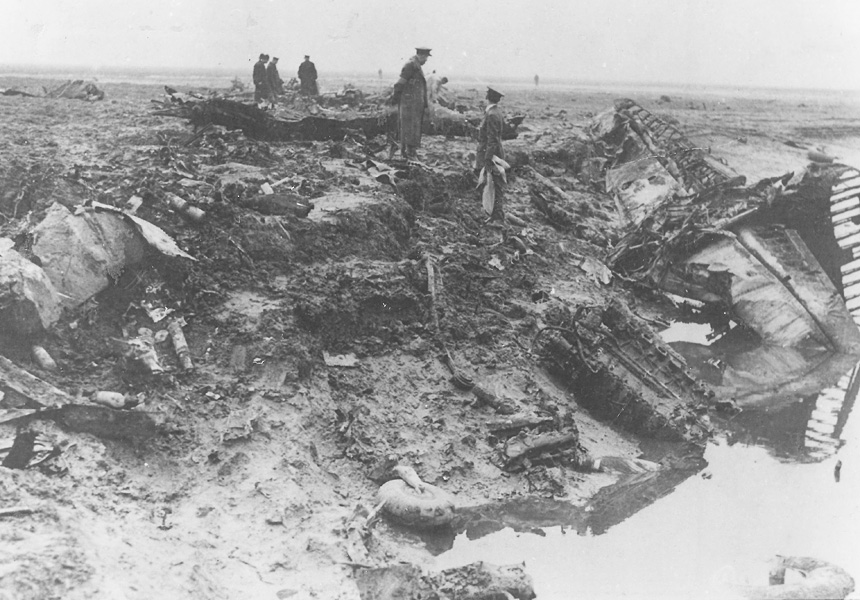 | 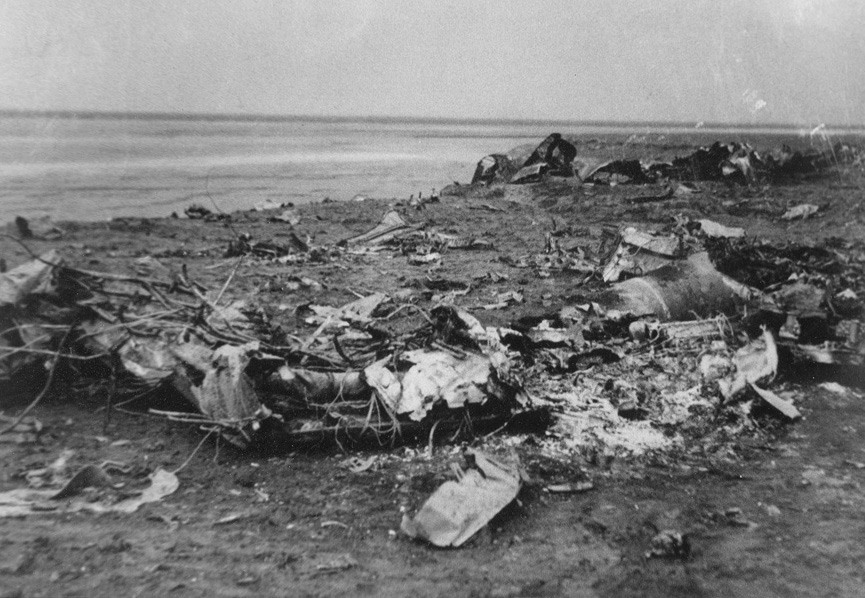 |
View of the wreckage
of the Ju88 scattered across the marsh the following morning - many of
the major components proved to still be in situ as shown in this photo
- albeit 10 to 15 feet below the surface now! (Photo: Russell Brown
Collection)
| Further burnt out wreckage of the Ju88 scattered across banks Marsh.
(Photo: Russell Brown Collection) |
 |
The
largest recognisable section of the Ju88 after the crash - amazingly
this proved to still be there, though only the anodised sections of the
spars and structure had survived.
(Photo: Russell Brown Collection) |
After
capture, both surviving German airmen were treated for their
injuries and initially taken to No.1 Prisoner of War Camp at
Grizedale Hall in the Lake District. Oblt. Klemm was transferred to
No.13 Prisoner of War Camp at Shap Wells Hotel near Penrith in May 1942
and due to the extent of his injuries he was later repatriated to
Germany as part of a prisoner exchange scheme in 1943. Lt. Coster was
transferred to Canada to No.30 Prisoner of War Camp at Bowmanville by
Lake Ontario. After the war Gunter Klemm flew as a pilot in the
reformed German Air Force and retired having reached the rank of
Lieutenant Colonel - He never forgot the kindness shown by those who
had rescued him and treated him at Lytham, later writing letters of thanks
and even inviting the daughter of the doctor who treated him to stay
with his family in Germany during a summer holiday. He died in 1972.
Heinrich Coster was transferred back to England in May 1946, returning
to Germany six months later - He died in 1971.
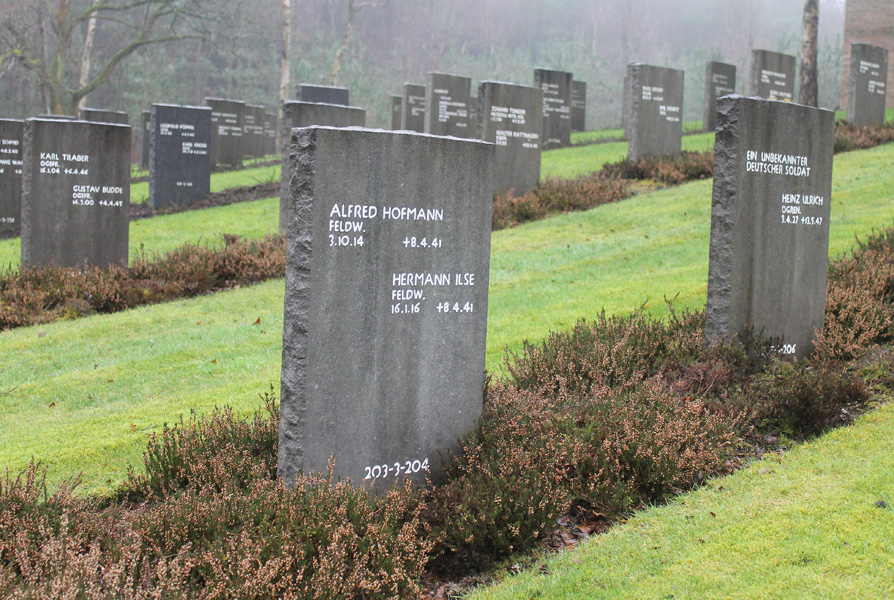 |
| Fw. Hofmann & Fw. Ilse both now lie at the German Military Cemetery, Cannock Chase, Staffordshire |
Exactly one month
after the destruction of the Ju88 over Banks Marsh, on the night of the
7/8th of May 1941, Flt. Lt. West and Sgt. Adams shot down another
Liverpool raider, this time He 111 Werke Nr. 2908 code G1+HP of 6/KG55,
which crashed near Wrexham. They were again flying Defiant N3445 and
Adams managed to shoot the enemy aircraft down despite only one of his
four turret guns being operational. Flt. Lt. West went on to be awarded
the DFC in September 1944 and eventually retired from the RAF in 1961
having reached the rank of Squadron Leader - He died in 2012. Sgt.
Adams was transferred to Bomber Command when the Defiants were
withdrawn from night fighter operations and he joined No. 405 (RCAF)
Squadron at Pocklington. On the night of the 29/30th of June 1942 he
was the rear gunner on Handley Page Halifax Mk.II. W1113 code "LQ - G"
for a bombing raid on Bremen in northern Germany. While flying over the
occupied Netherlands the bomber was shot down by a night fighter and
all the crew were lost. Sgt. Adams was 21 years old and he is buried in
the churchyard at Noordwolde, Weststellingwerf, Netherlands.
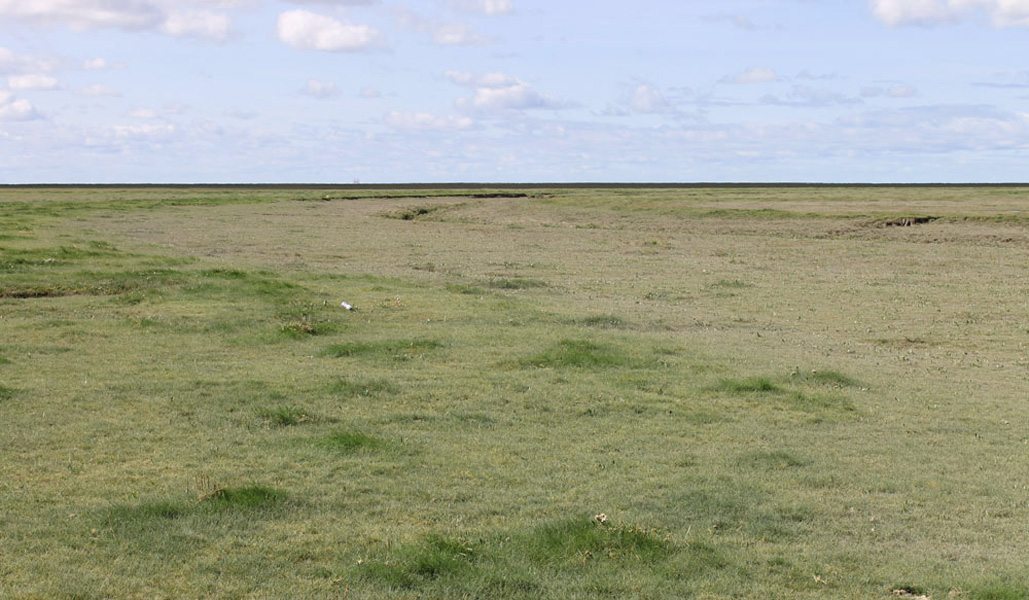 | 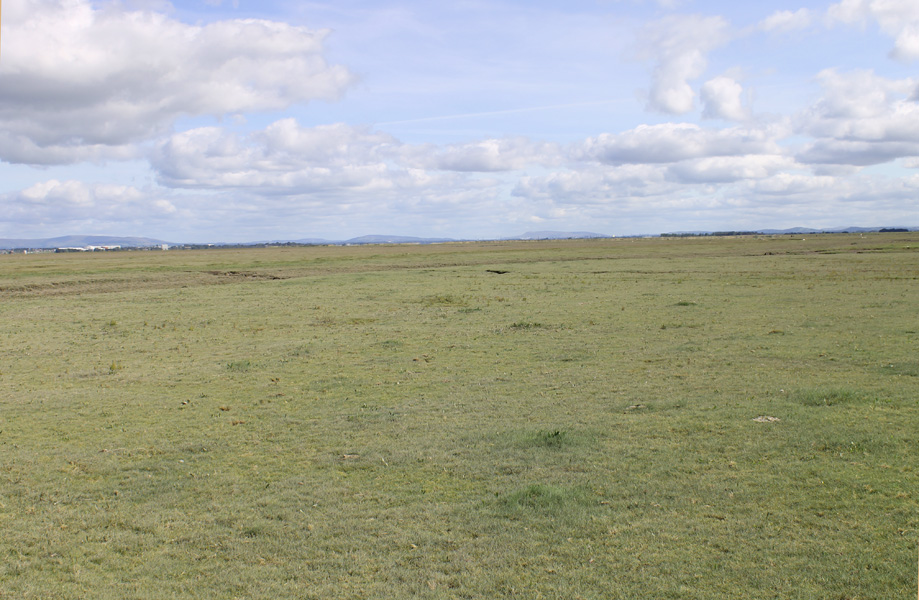 |
| Banks Marsh today is a huge nature reserve covering 4,697 hectares (11,613 acres) | With no static landmarks to guide us, eyewitness accounts proved of limited use. |
Banks
Marsh, where the Ju 88 impacted, is now managed by Natural England as a
nature reserve and is part of the Ribble Estuary SSSI (Site of Special
Scientific Interest), with areas used for cattle grazing and
wildfowling and covers a considerably larger area than it did in 1941,
when much of it was open sands extending out into the estuary. The area
is used by large numbers of migratory birds as winter feeding grounds
and this combined with the nesting of native species in late spring and
early summer means that access to the site is only permitted in early
spring and late summer. Our efforts in the 1990s concentrated on an
area indicated following interviews with numerous witnesses who either
recalled the crash or who had seen visible wreckage, which was present
up until the early 1950s. However, the marsh has been steadily building
up over the last 76 years and with no static landmarks to rely on, such
memories proved inaccurate and our early searches we were also plagued
by our detection equipment mysteriously refusing to operate properly
due to the ground conditions and mineralisation. Later searches used
two Foerster Ferex 4.015 vertical gradient magnetometers to grid search
the indicated areas, which proved more reliable, but still with no
success. Finally in 2015 we decided to re-assess all the evidence and
have one more concerted effort to find the crash site. Whilst reviewing
photographs taken immediately after the crash, it was clear that the
crash site had been at the edge of the marsh and from the areas of
shadow in the photos it was deduced that the section of tidal channel
visible was orientated roughly east-west, with the elevated mud flats
running along the south side and a sand bank on the north side. On
examining an original aerial survey photo of the marsh from 1945, we
found only one area that appeared consistent with the features. This
information was then overlaid onto a modern aerial photo of the area
revealing that the line of the 1940s edge of the marsh was in fact some
distance from the modern day tidal gutter widely thought to mark the
original edge of the marsh. This then formed the baseline for a renewed
grid search, again using a Foerster Ferex 4.015 and a more advanced
4.021 magnetometer, which resulted in a major contact being detected
only a few metres from the baseline. A probe rod confirmed a solid
object at a depth of around 5 feet and following discussion with the
Reserve Manager and local SSSI Officer from Natural England, approval
was given to investigate this magnetometer contact further.
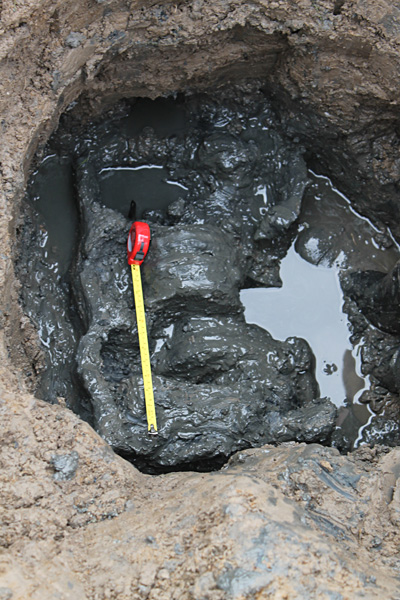
|
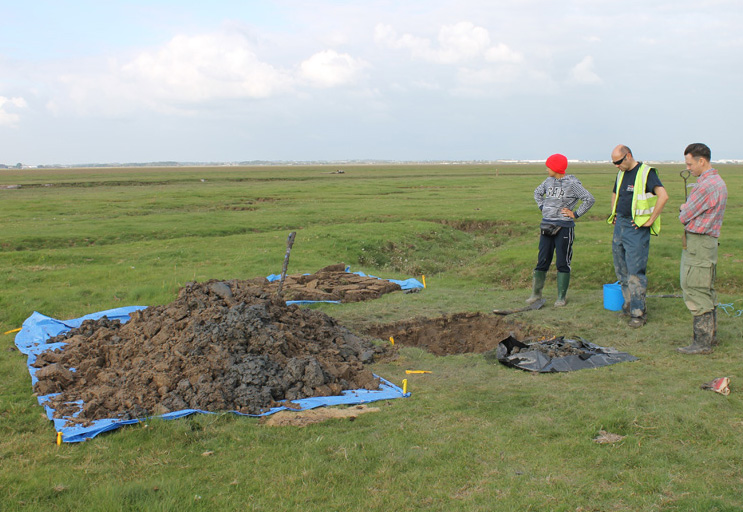
| 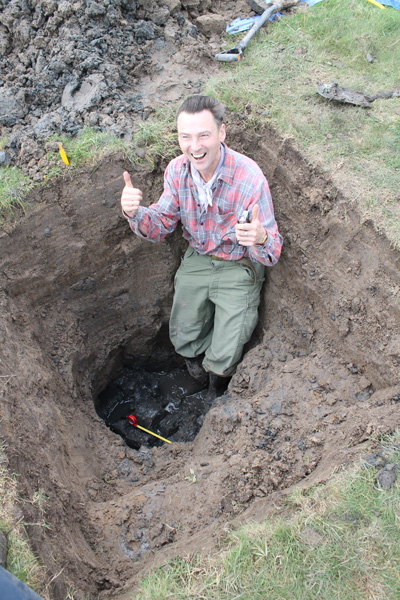 |
| At approx. 5'6" the crankshaft of a large alloy cased engine is revealed |
Test Pit going in over the first magnetometer contact | One
of our members - Russell Brown - who has been researching the fate of
this aircraft for longer than any of us, is clearly delighted at
finally seeing tangible evidence of the Ju 88 |
A few weeks later a limited test pit uncovered a crankshaft still
attached to a major portion of a large alloy cased engine, visible
within the confines of the pit. This was quickly identified as a
Junkers Jumo 211 engine and having confirmed this, the test pit was
infilled and the covering grass reinstated. Now began the complex task
of organising a full scale excavation and negotiating with the various
authorities with an interest in the wreckage and the sensitive
environment of the marsh. An early task in this respect was to organise
a full geophysical survey of the crash site and a few months later we
were very fortunate to be able to arrange for Peter Masters, a forensic
archaeologist and research fellow from Cranfield University, to
complete a survey of the site using a Bartington Single Axis Magnetic
Field Gradiometer. The results of this survey revealed the full extent
of the buried wreckage and allowed us to plan our excavation so as to
minimise disturbance of the sensitive surrounding area.
Although
we had by now demonstrated to most of the agencies concerned with the
site that we could carry out an excavation with due care and keep
within their terms, we still had one final important task before we
could proceed which was, of course, to obtain a licence from the MOD.
This we knew might be problematic, as there was the not insignificant
fact that this aircraft had been an enemy raider loaded with bombs
that, fortunately for the people of Liverpool, never reached their
target! Although several sources mentioned the aircraft's bomb load,
what happened to it proved more problematic as different sources proved
somewhat contradictory, especially the local newspaper reports of the
time. In the end we decided that the official Air Intelligence reports
were likely to be the most reliable, with the first - the A.I. 1 (K)
report, from the interrogation of prisoners, stating definitely only 2
x SC500 bombs carried and that one was jettisoned during the attack and
the other remained in the aircraft but did not explode. The second -
the A.I. (G) report, from the inspection of the crash site, states two
bombs were found amongst the wreckage - both 500kg, with one partly
detonated and one unexploded. This information also tied in with most
newspaper reports, though there was confusion due to other bombs
falling in the area around the same time and most witnesses assumed
that a bomb had detonated when the aircraft crashed. With both bombs
accounted for and having been visible on the surface, it was obvious
that they must have been dealt with soon after the crash - though
unfortunately the records of the local bomb disposal unit at the time
did not go into any detail. But this was sufficient to allow a licence
to issued, conditional on all work ceasing should anything suspicious
be found and recommending that an EOD team should attend the excavation
or at least be aware of it and on standby just in case.
 |
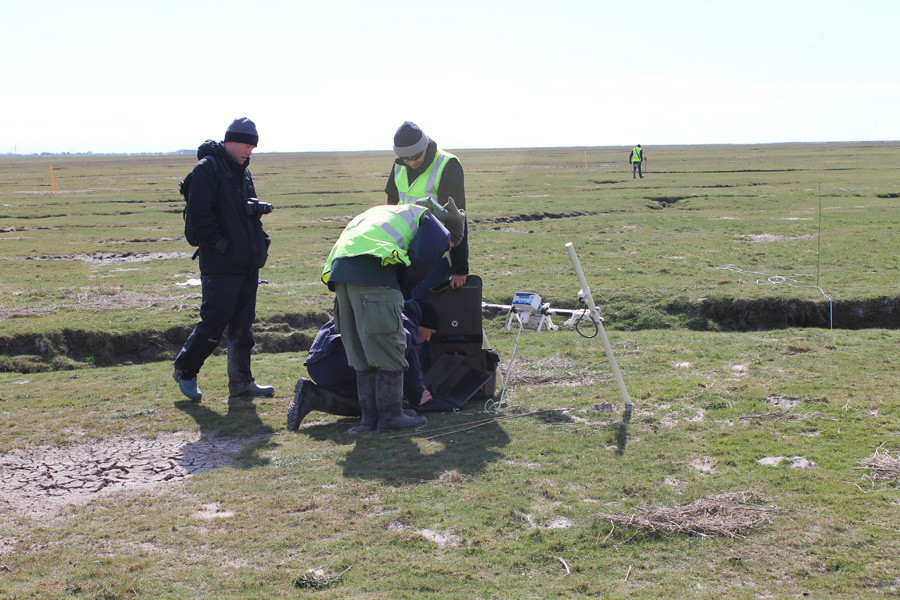
|
| Geophys survey gets underway |
Checking results part way through the survey |
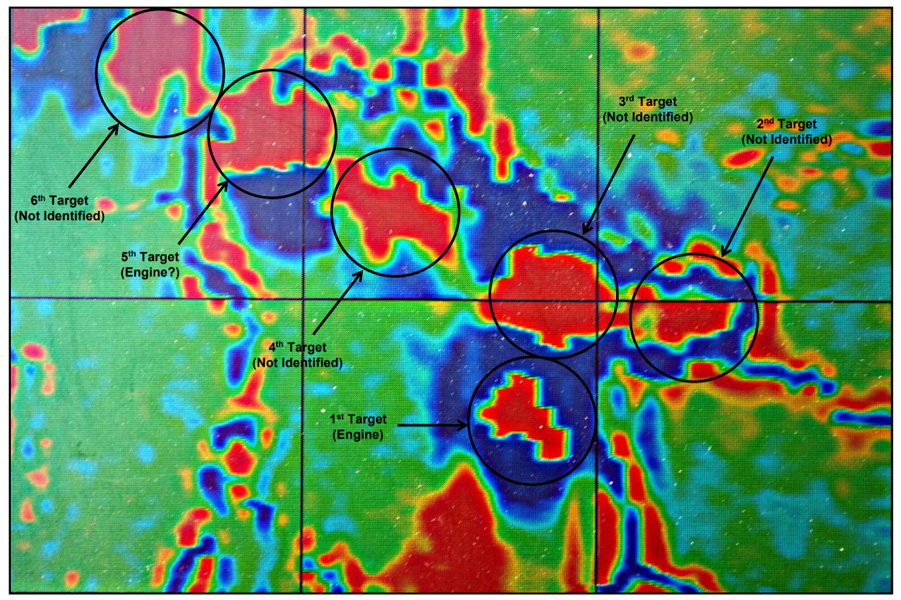 |
| Overall results of survey, with initial tentative identification of some targets |
With all the formalities finally completed, the excavation was
scheduled to take place over two days on the 3/4th July 2017 and now
the logistics took precedent; plant equipment was booked, the nature
reserve workshop and office building was generously made available by
the warden for use as our dig HQ, contact was made with EOD, but at the
last minute they were unable to attend due to the security situation at
the time. Finally a film crew from Emporium Productions, was invited to
record the dig as part of a documentary series for the History channel.
Numbers out on the marsh crash site had to be limited, but we managed
to accommodate a couple of VIP visitors, including Guy Salkeld, an
Archaeologist with the Ministry of Defence, Joanne Chamberlain,
Documentation officer at the Atkinson Centre Museum in Southport and
Col. Hermann Hanke, Air Attaché at the German Embassy in London.
The
first day of the dig went largely according to plan, with the first
trench opened over the engine we had already identified and enlarged to
take in surrounding contacts located by our surveys of the site.
Although soil conditions were good, with very little water ingress, we
very quickly found that, as expected, the edges of any
excavation soon became unstable and entering the trenches to
recover artefacts was not really an option. The mechanical excavator
operator was directed to dig around larger items and briefed how best
to lift each item to avoid causing damage. Additionally several of our
team took up positions to monitor the spoil as it was removed and
spread out to ensure no smaller objects were missed. Soon we had
identified and lifted two ECT500 external bomb racks, a complete engine
flame damper unit and the starboard Jumo 211B engine. Below and to one
side of this we uncovered; parts from the dive brake operating system,
a main undercarriage oleo leg, assorted airfame sections, which
appeared to be mainly from the engine nacelle area and a VDM propeller
hub, complete with two alloy blades still attached. At approx. 10 feet
in depth, with no more aircraft remains present, the trench was shut
down and infilled, taking care to preserve the stratification of the
material removed. Trench two was then opened over the next contact, but
initially there did not appear to be any aircraft remains present.
However, our detection equipment confirmed a contact, so we continued
deeper and at approx 15 feet in depth a tyre was revealed in the wall
of the trench and a few smaller airframe pieces were recovered. The
tyre was carefully uncovered and was identified as a mainwheel tyre and
proved to be intact and still had the remains of the wheel hub present,
though the magnesium wheel itself had long since corroded away. With
the tyre / wheel hub lifted and apparently no more remains present the
trench was closed down and infilled.
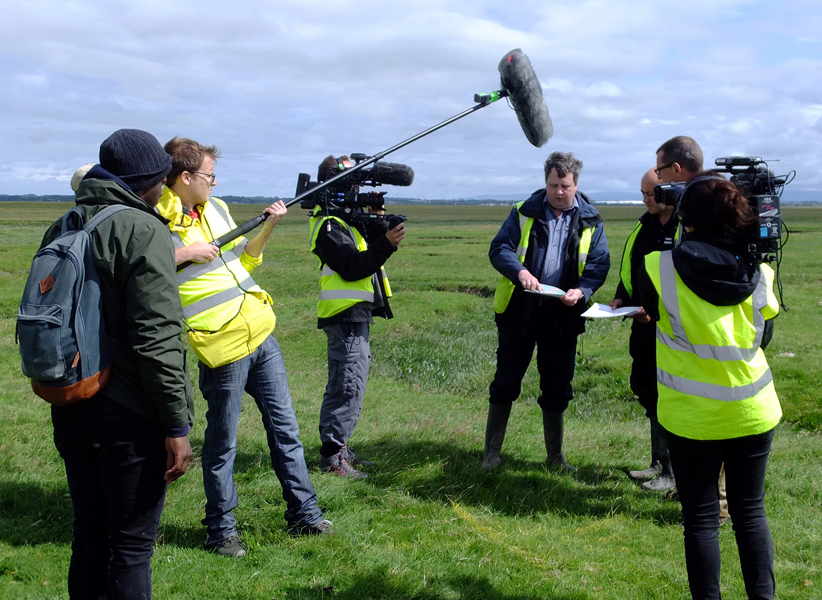 |
| Setting the scene for the film production company - note yellow "X" marks the spot on the grass! |
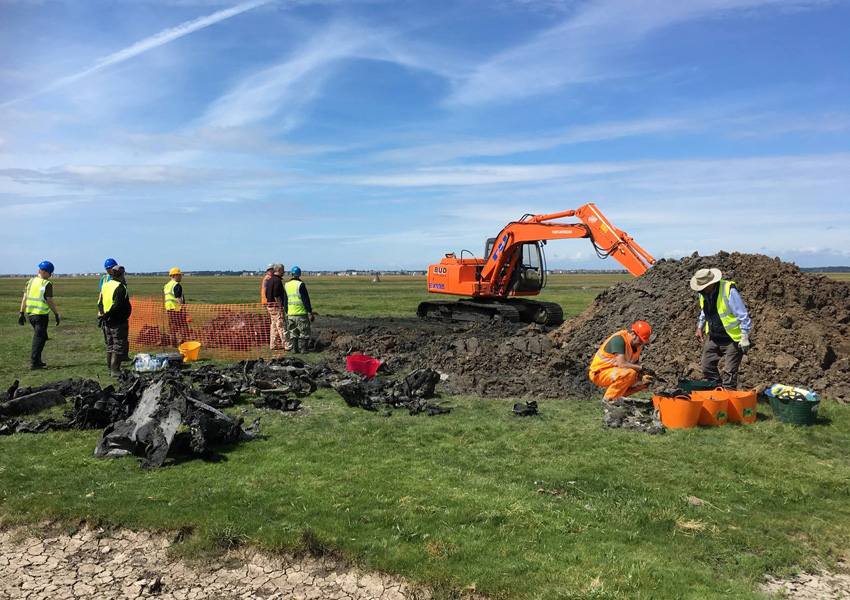 |
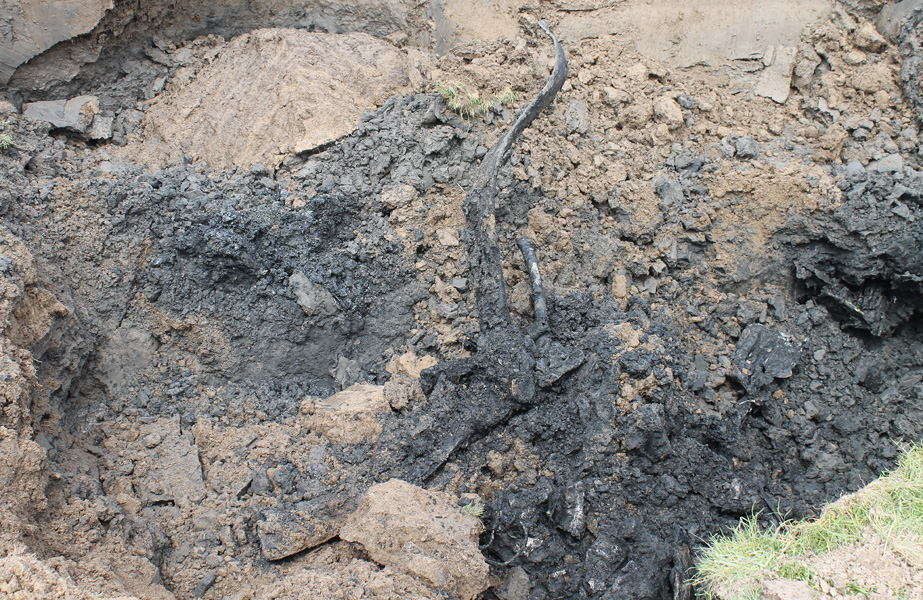 |
| Day one of the dig well underway | VDM Propeller with two blades still attached and other wreckage revealed below the fist engine |
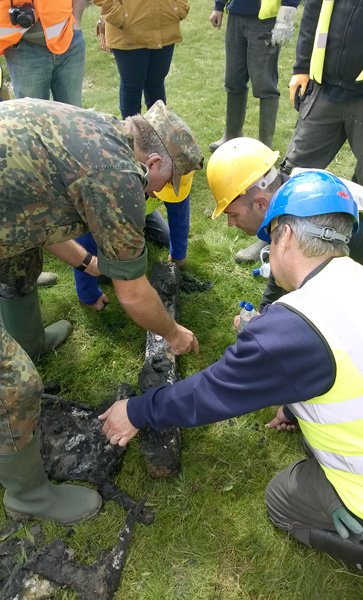 |

|
| Col. Hanke, Air
Attaché at the German Embassy in London, translates information plates
on an external 500Kg capacity bomb rack | First
Jumo 211 - the starboard engine recovered from the marsh and back to
dig HQ thanks to NW Heritage supplied tracked crawler truck |
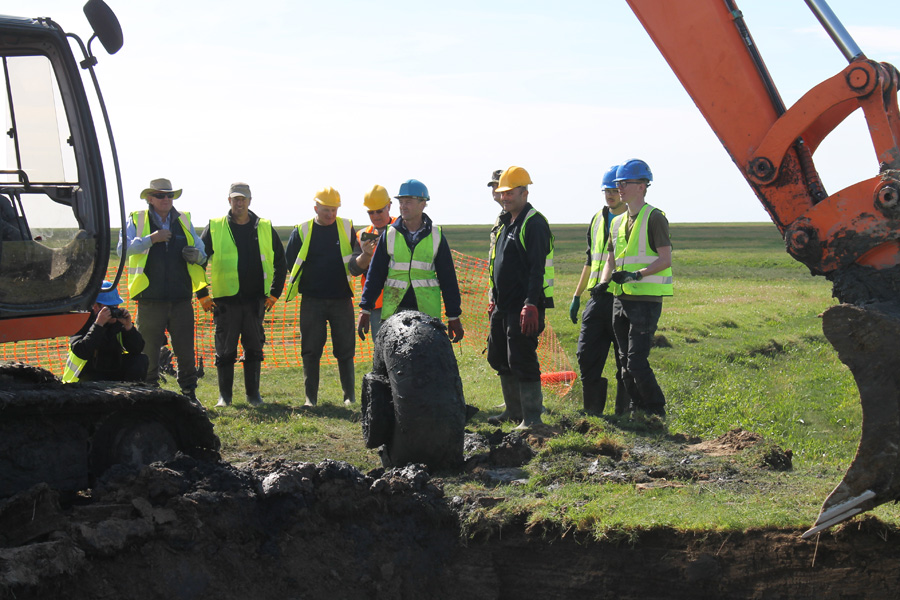 | 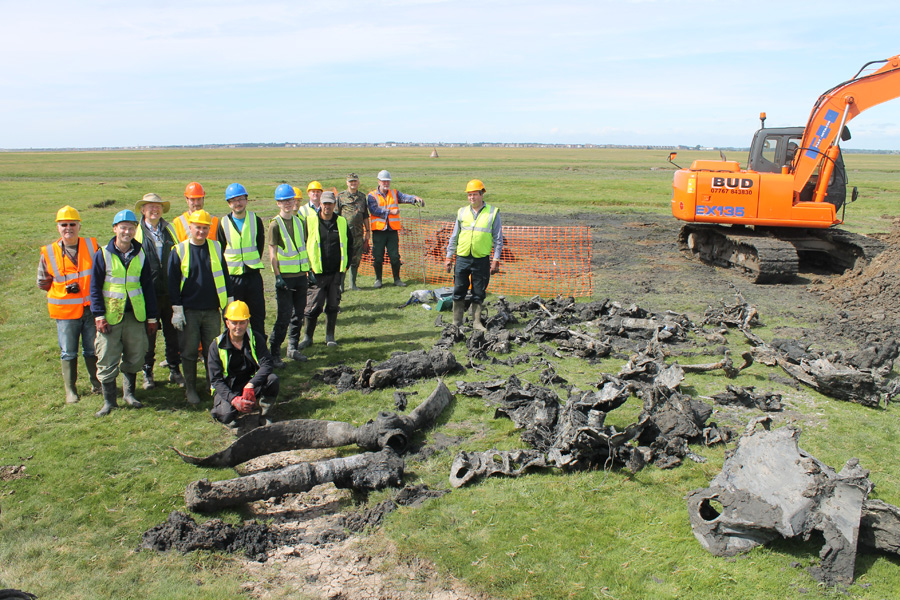 |
| Mainwheel
tyre with remains of the wheel hub still present - this item can
be seen floating at the bottom right of the first 1941 wreckage photo
above and was recovered from a depth of 18 feet! | Lancashire
Aircraft Investigation Team members and guests with the results of the
first day of the dig - note: the starboard engine is behind the safety
barrier. |
Day two started with opening a trench over a major contact that had
been indicated by both the gradiometer and magnetometer instruments,
which we assumed must be the second engine. However again there
appeared to be little in the way of aircraft remains despite the
readings, until at about 10 feet down, when the remains of one of the
steel reinforced centre section beams was found,
embedded vertically, closely followed by a second beam, with their
orientation probably resulting in the very strong magnetometer signals.
As this trench was being closed down, we returned to the geophys survey
to see if there were any clues we had missed as to where the second
engine might lie and noted partial coverage of a contact right on the
edge of the survey area. Fortunately Timothy Schofield of Suffolk
Archaeology was attending the dig as part of Emporium Productions team
and just happened to have his geophys equipment with him! An hour or so
later we had an extended gradiometer survey covering the whole of the
contact, which was then confirmed by the writer using a Foerster 4.021
magnetometer as including a major ferrous contact, rather than just an
area of burnt-out remains, which we had discounted it as being previously.
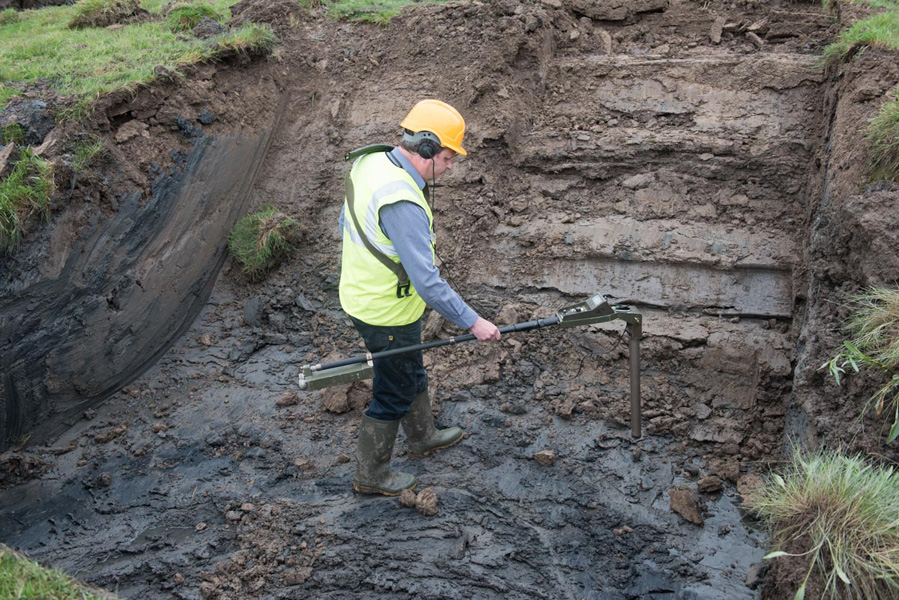 | 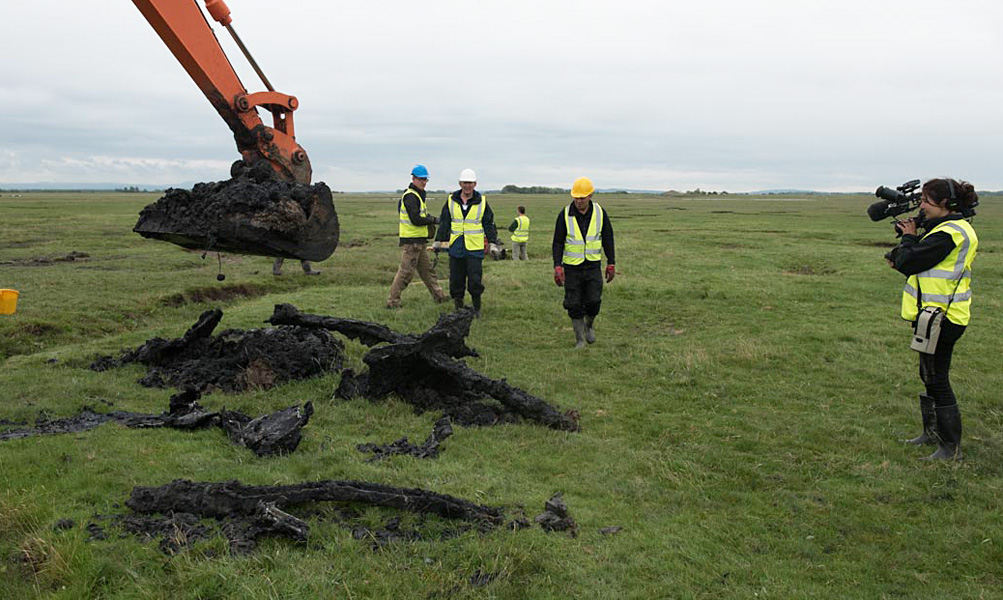 |
| Day two - pinpointing the target that we initially believed to be the second engine | In
fact, it proved to be two heavy steel centre section beams and a small
amount of associated wreckage from the wing mounting area of the
fuselage |
A
fourth trench was immediately opened over this contact and at approx 8
feet in depth, one of our team used a probe rod to ascertain the exact
location and depth of the remains in order to guide the machine
operator. This showed that substantial wreckage lay only another couple
of feet down and the digger driver proceeded accordingly, soon
revealing another pair of steel reinforced centre section
wing spar beams. These were lifted partially out of the hole so that
lifting straps could be attached, as they were still joined to the
remains of a wing spar, which when pulled clear proved to be over 20
feet long. Once this was removed, the trench was re-checked with the
magnetometer and with a substantial reading still present, digging
continued. Shortly after this the machine operator indicated he had
made contact with a large object, but due to water ingress and the
liquid mud at the bottom of the now 12 feet deep trench, we could not
identify what this might be. Even once the object was in the machine's
bucket it was not immediately obvious what it was, as the size was
similar to an engine and its outline was obscured by mud and
concretion, but once on the surface it rolled out of the scoop on to
the grass and members of the LAIT team immediately knew their worst
suspicions were realise and they were looking at an SC500 (SC =
Sprengbombe-Cylindrisch & 500 = the overall weight of the bomb in
kg) high-explosive general purpose bomb!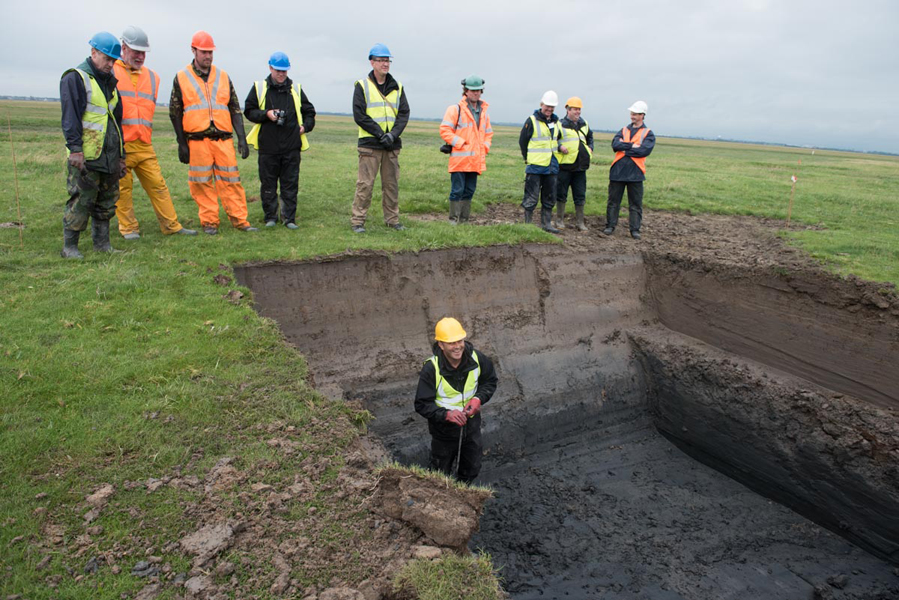 | 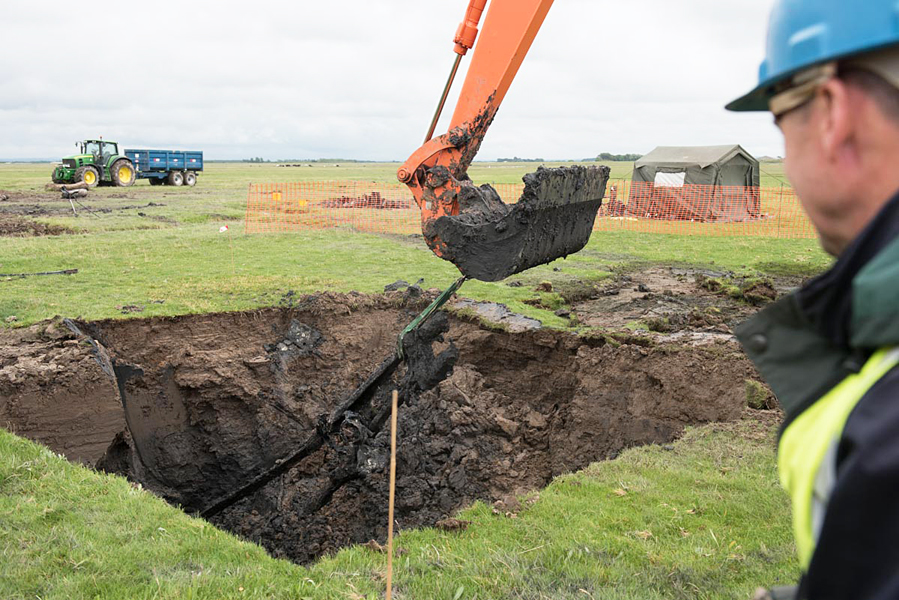 |
| Trench
No. 4 opened up and again pinpointing location and depth of wreckage to
guide the digger driver - this location corresponded with the second
burnt-out area of wreckage in the 1941 photos | First
find was the other two steel beams that made up the fuselage centre
section attached to a 20 foot long section of wing spar - but once
removed a substantial magnetometer contact remained. |
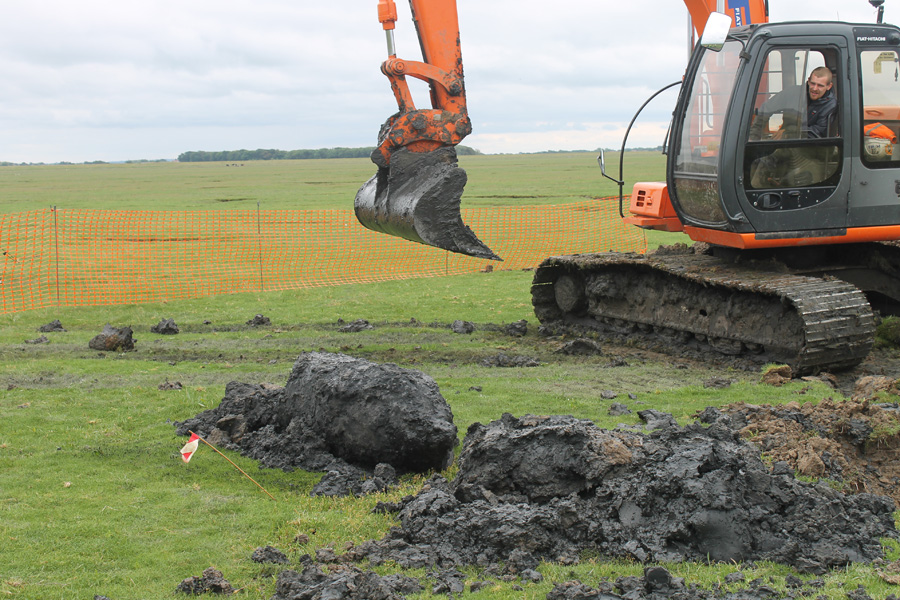 |
| Not an altogether welcome find - though not totally unexpected either - The SC500 bomb. |
This was, of course,
the signal to close down the dig, notify the police and clear the site
pending the arrival of EOD. The film crew and visitors made their way
back to the Nature reserve HQ, which at 900 meters away was deemed a
safe distance and a member of the LAIT team remained at site to await
EOD and to ensure no cattle came near the still open excavation. On
arrival EOD asked to be briefed on the background of the find and were
very pleased to hear it was on the surface - not still 12 feet down in
a water and mud filled hole - so no drysuits needed! Less than an hour
later the all clear was given and the bomb proved to be, as our
research had indicated, completely burnt out and was declared F.F.E.
(Free from explosives) - but you certainly can't be too cautious with
such things! Unfortunately this meant the end of our excavation for the
time being, as the plant equipment was booked elsewhere and we only had
time to fill in and reinstate the last trench the following morning.
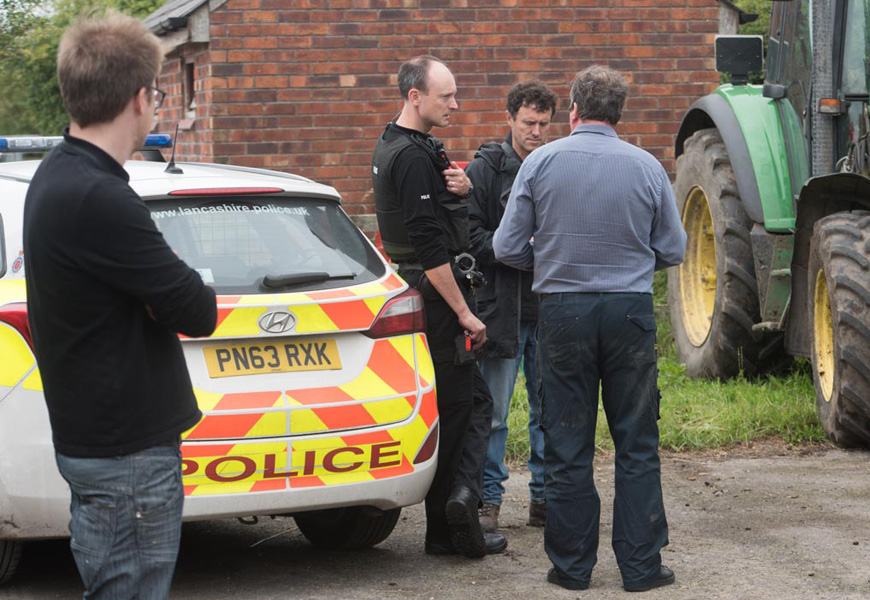 | 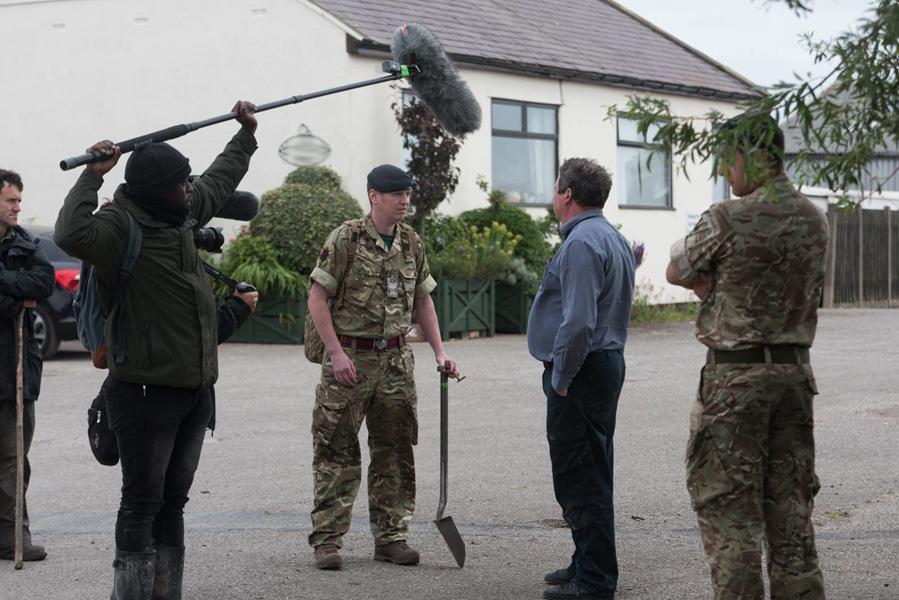 |
| Now things started to get complicated! Explaining the situation to the police on arrival. | Briefing EOD personnel before they go out on to the marsh |
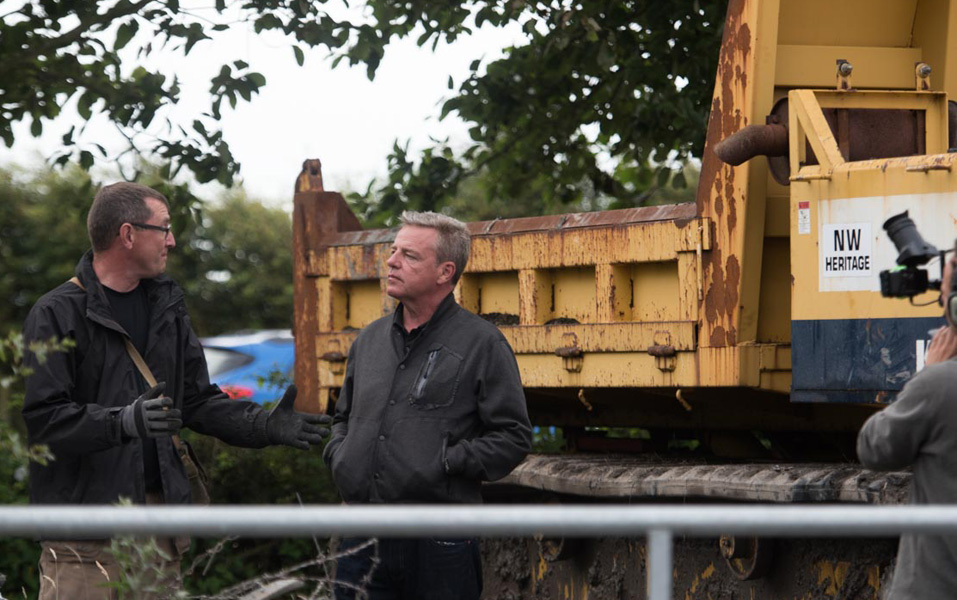 |  |
| Meanwhile
the film company carried on as best they could - Stephen Taylor
dicusses our finds with series frontman Graham McPherson (aka Suggs) | Once
it had been declared safe, one of our team, Eric Watkiss ( left) shows
the Senior Reserve Manager, David Mercer our "find" with some
added assurance from EOD! |
 |
| The SC500 intended for Liverpool in 1941 could have taken out an entire street - but is now a harmless relic. |
It
was not to be until the beginning of September that we were able to
return to the site, thanks to the generosity of local firm of John
Robson Metals Ltd, who offered to provide the necessary plant equipment
to enable us to finish the project. In the meantime we had re-surveyed
the site using magnetometers and discovered that Trench two had, in
fact, been dug too far over and away from the main magnetometer contact
- which was still there! But the signal was much clearer now that
interference from the other buried large objects close to it had been
removed. Fortunately we were also still within the permitted
period for accessing the marsh and on a pleasantly sunny 2nd September
we reassembled at the site and once the tide in the nearby channels
began to fall, we reopened trench two. At first there was little to see
and we had to proceed carefully as the refilled previous trenches
threatened to make the edges of the new trench even more unstable. Then
a large object was encountered and lifted, which proved to be the
second main undercarriage leg, followed by, at approx. 12 feet in
depth, an even larger object being located, just as the bottom of the
hole began to fill rapidly with water and liquid mud. The digger driver
worked quickly and was able to clear around the object and with
guidance from the far side of the excavation, as he could not see due
to the depth, the object was rolled into the bucket and lifted,
revealing the distinctive profile of a large "V" configuration engine -
the missing second engine and a satisfactory conclusion to the dig. | 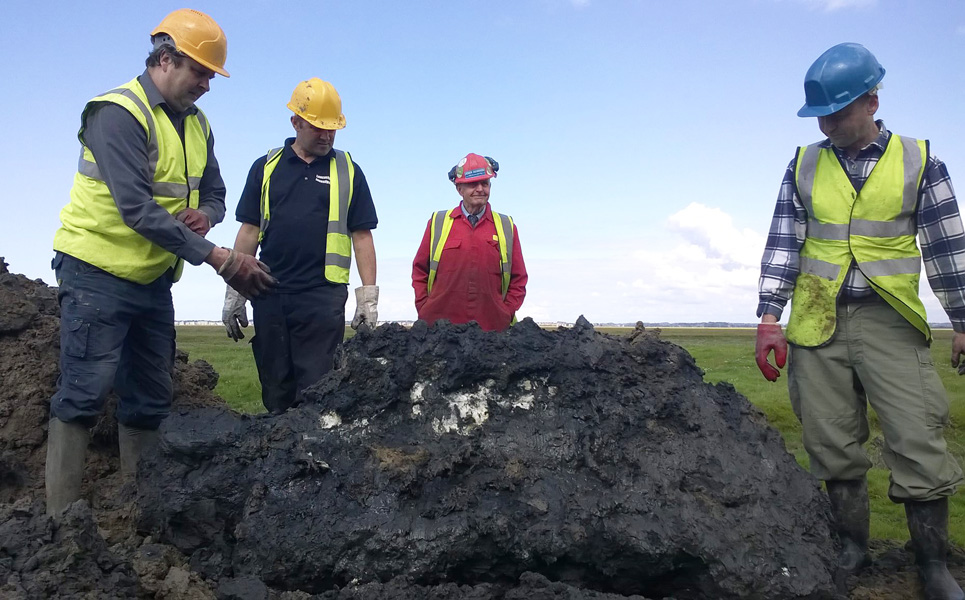 |
| Excavation of the second engine proved more difficult as the already disturbed ground made the sides of the hole unstable. | The
"lost" second engine successfully recovered. Left to right are LAIT
members: Nick Wotherspoon, Antony Eric Watkiss, John Robson and Russell
Brown. |
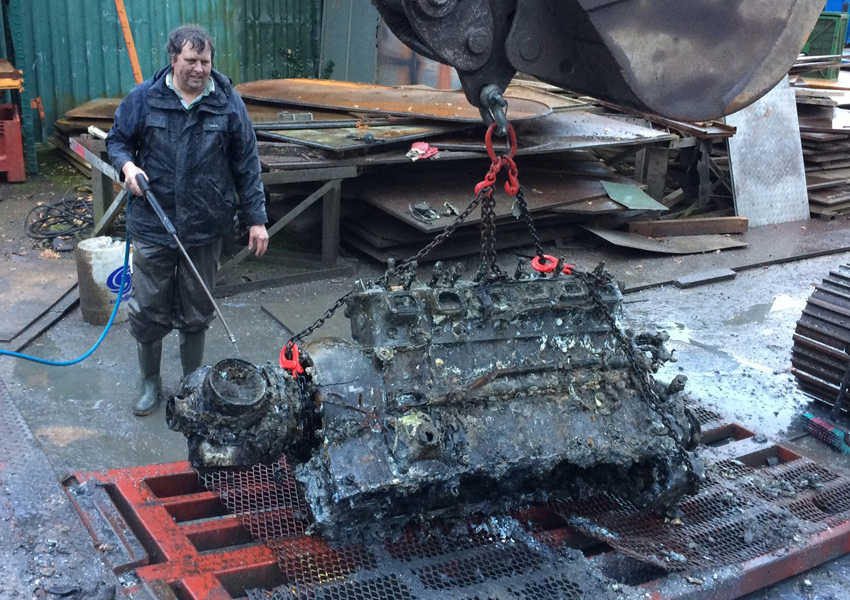 |
| Cleaning an engine from a dig is always a messy business |
Members
of our team are likely to be fully occupied for some time cleaning
and conserving the finds from this dig to get them ready for public
display - one local museum has already expressed an interest in putting
on a display of representative finds and other local venues are also
being considered for temporary displays, so that people local to the
crash site will get an opportunity to view the finds. But the likely
permanent home for the remains will be our newly refurbished exhibition
room, located at the "Hangar 42" museum / visitor's centre at Squires
Gate - in an original wartime hangar that once housed the
Defiants of No. 256 Squadron ! |  |
| Items from the Ju 88 on temporary display at Hangar 42, Blackpool, awaiting custom made stands | Partly cleaned Starboard engine showing severe fire damage |
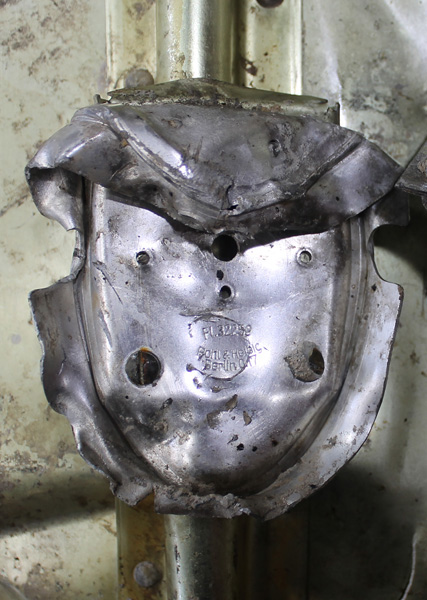 | 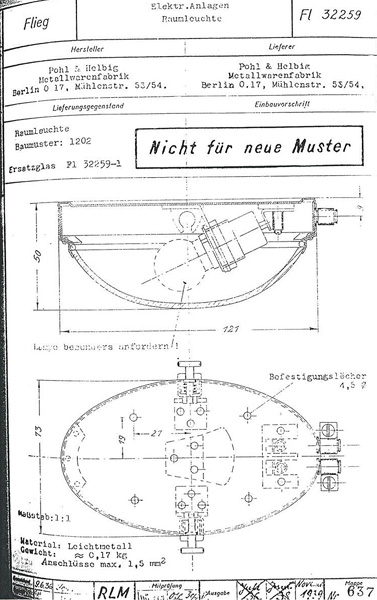 |
| Remains of a bulkhead work light from bomb bay of Ju 88 | Original maker's specification sheet for Ju 88 bulkhead work light |
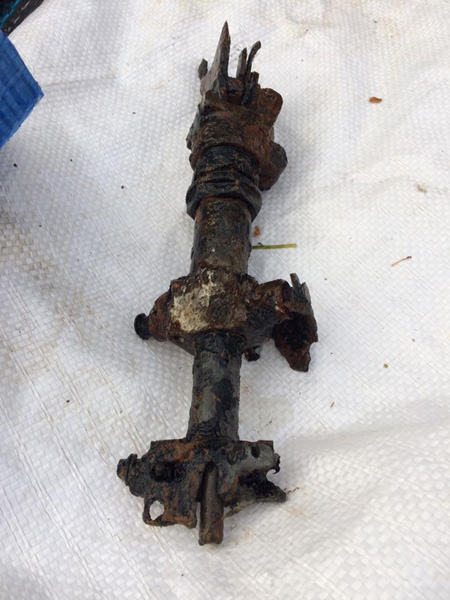 | 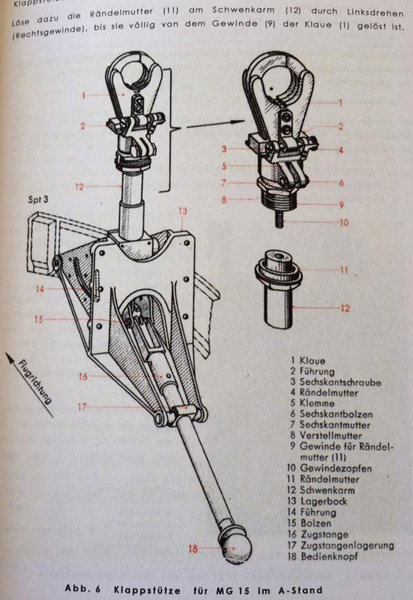 |
| "Klappstutze" securing clamp for MG15 machine gun from front of Ju 88's cockpit | "Klappstutze" diagram from Ju 88 operation manual |
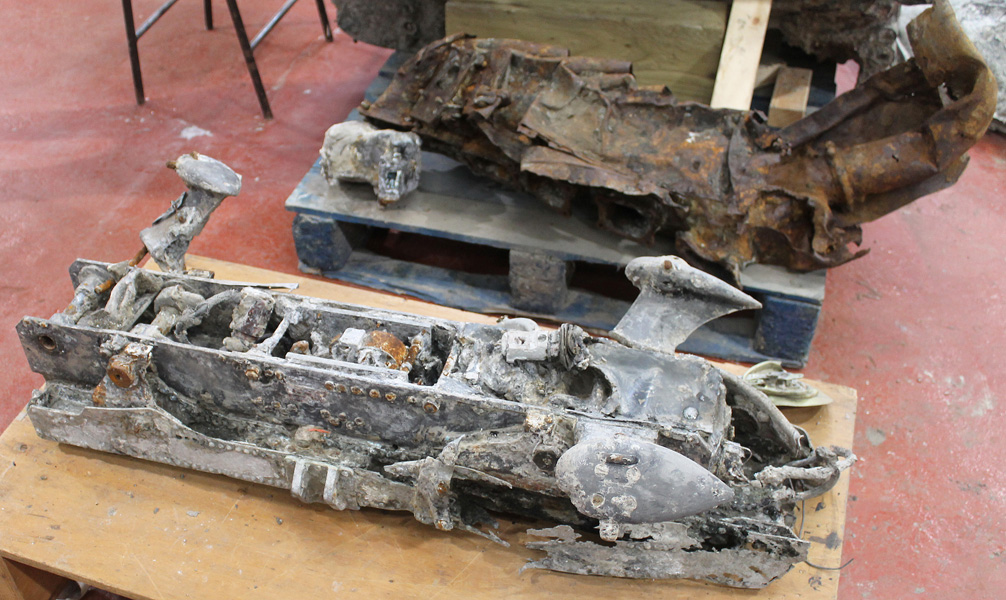 |  |
| ETC500 external bomb rack after initial cleaning - item in background is a flame damper unit from one of the engines. | Caricature
in pencil, captioned "Leibnitz" found on part of dinghy stowage
structure - presumably poking fun at someone in authority on the
production line? |
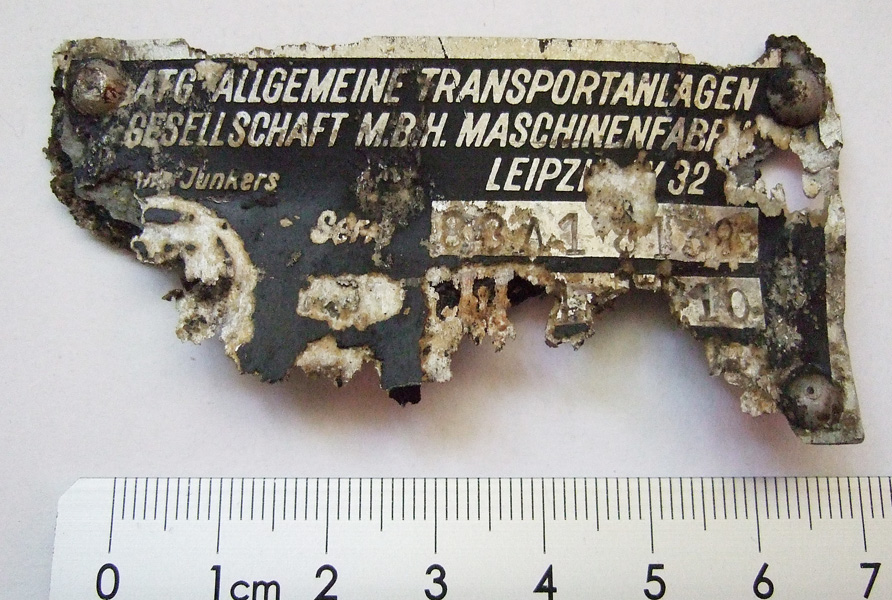 |
| Finally
- a chance find during the cleaning of the second engine was this ATG
manufacturers plate - Allgemeine Transportanlagen GmbH (ATG) at Leipzig
- a company that manufactured the tail sections and fuselages for the
Ju88, as well as carrying out final assembly of the
aircraft - Note: it bears the inscription "88" for the aircraft type, "A1
" for the aircraft sub-type ( Many Ju 88 A5s were initially being
constructed as A1s on the production line but were upgraded to the
later A5 specification before completion) and "8138" - The Werke No. that identifies this individual aircraft. |
Acknowledgements:
David Mercer, Hannah Birtles, John R. Robson, Paul Johnson, Andy Saunders, Guy Salkeld, Tim Schofield, Peter Masters
Photos: Nick Wotherspoon, Russell Brown, Alan Clark, Gareth Brown, Mark Sheldon, Eric Antony Watkiss, Graham Berry.
This page & all articles on this site
Copyright © Nick Wotherspoon 2018













































